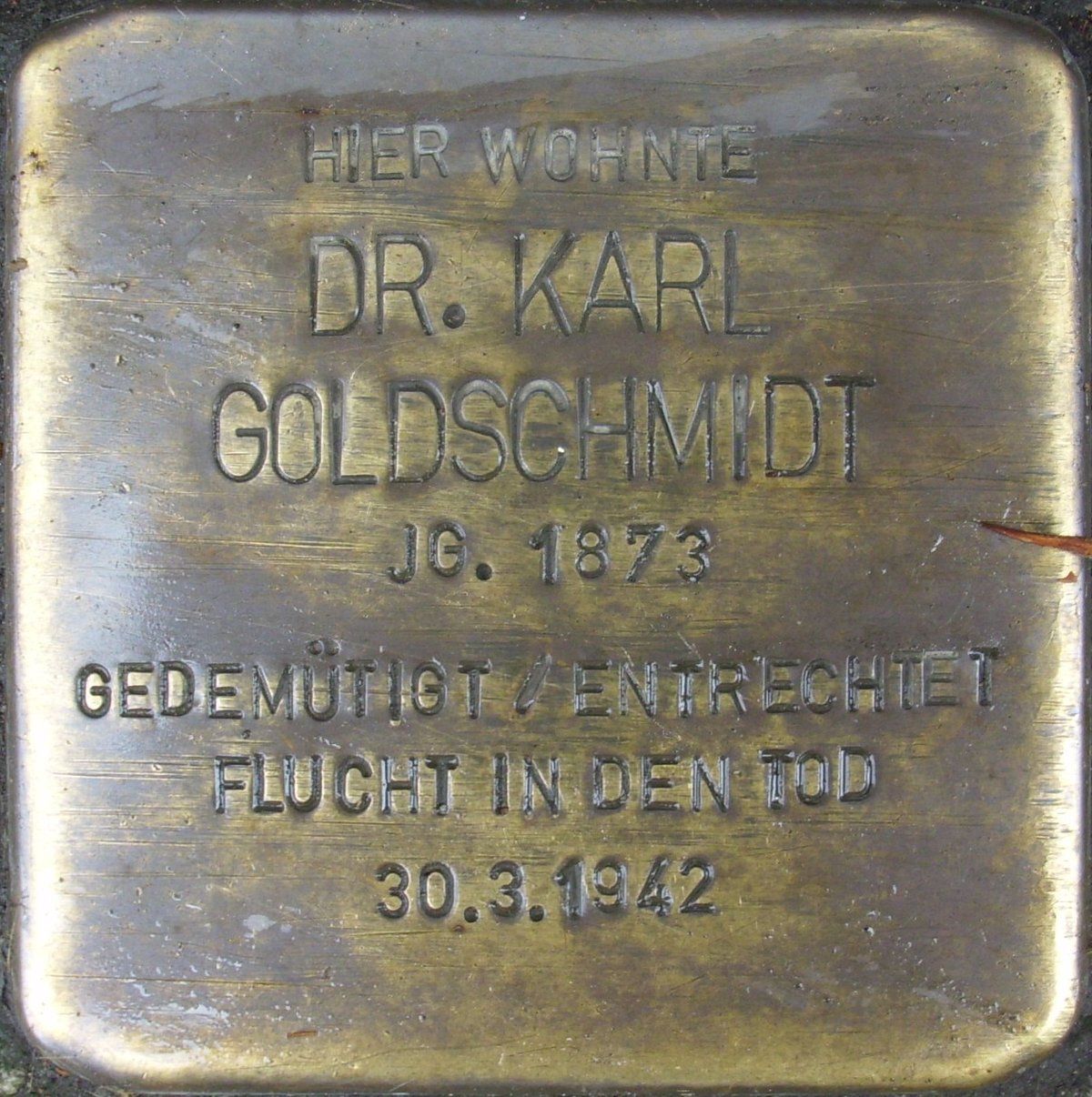
Stolperstein Visiting Hours, Tickets, and Historical Significance in Mainz, Germany
Date: 14/06/2025
Introduction
Mainz, known as “das goldene Mainz,” is a city marked by over a thousand years of vibrant Jewish presence and cultural achievement. Among the most moving reminders of this legacy are the Stolpersteine—small, brass memorial stones—scattered throughout the city’s pavements. One such Stolperstein honors Dr. Karl Goldschmidt, a distinguished Jewish lawyer whose fate during the Holocaust is commemorated at Klarastraße 13. This guide details the historical significance of the Stolperstein project, provides practical information for visitors, and situates Dr. Goldschmidt’s memorial within Mainz’s broader Jewish heritage.
For further information, visit the Stolpersteine Mainz project and the official Mainz city cultural website.
Table of Contents
- Jewish Life in Mainz and the Goldschmidt Family
- The Rise of Nazi Persecution and the Fate of the Goldschmidts
- Visiting the Stolperstein for Dr. Karl Goldschmidt in Mainz
- Nearby Historical Sites in Mainz
- Frequently Asked Questions (FAQs)
- Plan Your Visit and Stay Connected
- References and Further Reading
Jewish Life in Mainz and the Goldschmidt Family
For centuries, Mainz has stood as a cornerstone of Jewish intellectual, religious, and communal life in Germany. The Goldschmidt family exemplifies the city’s Jewish bourgeoisie before the Holocaust. Josef Goldschmidt, born in 1876, established a men’s tailoring business and, with his wife Johanna (Hannchen) Fröhlich, raised eight children in Mainz. Their home and business at Klarastraße 13, which included the “Restaurant Goldschmidt,” was a hub of Jewish social life and later became a sanctuary for those increasingly marginalized by Nazi policies (Stolpersteine Mainz – Familie Goldschmidt).
The Rise of Nazi Persecution and the Fate of the Goldschmidts
The Nazi regime’s rise in 1933 initiated a relentless campaign of antisemitic laws, social exclusion, and violence that devastated Mainz’s Jewish community. The Goldschmidts’ experiences mirror those of countless other families:
- Leopold Isaak Goldschmidt and Max Meier Goldschmidt, the eldest sons, perished in the Holocaust. Max Meier was deported to Izbica and likely murdered in Majdanek in 1942. Leopold’s fate remains uncertain, though family testimony affirms his death during the Shoah.
- Manfred Moses Goldschmidt suffered from illness and was institutionalized under discriminatory Nazi policies.
The Stolperstein for Dr. Karl Goldschmidt stands as a testament to these personal and collective tragedies, while also acknowledging the family’s contributions to Mainz’s cultural life.
Visiting the Stolperstein for Dr. Karl Goldschmidt in Mainz
Location and How to Find It
The Stolperstein commemorating Dr. Karl Goldschmidt is set in the sidewalk at Klarastraße 13, Mainz—the site of his family home and restaurant. The memorial can be reached easily on foot from Mainz’s historic center. For up-to-date locations and further biographical details, consult the Stolpersteine Mainz database or the official Stolpersteine project website.
Visiting Hours and Tickets
Stolpersteine are public memorials embedded in city sidewalks; they are accessible 24/7, with no admission fee or ticket required. Visitors are welcome at any time.
Guided Tours and Visitor Tips
Mainz offers several walking tours focusing on Jewish history, including Stolpersteine. Guided tours through organizations such as the Verein für Sozialgeschichte Mainz e.V. provide deeper context and personal stories that enrich the visitor experience (DieReiseEule).
Visitor etiquette:
- Approach the Stolperstein with respect; avoid stepping directly on it.
- Quiet reflection is encouraged. Flowers or small stones can be left as tributes.
- Photography is permitted, but please do so discreetly.
Accessibility
The Stolperstein is at ground level on a public sidewalk, generally accessible to people with mobility aids. However, some historic streets in Mainz may have uneven surfaces.
Nearby Historical Sites in Mainz
Enhance your visit by exploring other important Mainz historical sites:
- Mainz Synagogue: A modern architectural landmark and active place of worship.
- Jewish Museum Mainz: Chronicling centuries of Jewish life in the region.
- St. Stephan’s Church: Renowned for its Chagall stained-glass windows.
- Gutenberg Museum: Celebrating Mainz’s legacy in printing history.
- Mainz Cathedral: A millennium-old Romanesque masterpiece (The Crazy Tourist).
Frequently Asked Questions (FAQs)
Q: Where is the Stolperstein for Dr. Karl Goldschmidt located?
A: At Klarastraße 13, Mainz, outside the former Goldschmidt residence and restaurant.
Q: Are there visiting hours or an admission fee?
A: No. Stolpersteine are public memorials, accessible 24/7 and free of charge.
Q: Are guided tours available?
A: Yes. Local organizations and the Mainz tourism office offer guided tours focusing on Stolpersteine and Jewish heritage.
Q: Is the site accessible for visitors with disabilities?
A: Generally yes, as the Stolperstein is at street level. Some sidewalks may be uneven.
Q: Can I take photos?
A: Yes, discreet photography is permitted. Please be respectful of residents and the solemn nature of the site.
Q: How can I participate in remembrance activities?
A: Community cleaning and memorial events are often held on January 27 (International Holocaust Remembrance Day) and November 9 (Kristallnacht anniversary). Visitors are welcome to join these efforts (Prague Views).
Plan Your Visit and Stay Connected
For a comprehensive, self-guided tour of Mainz’s Stolpersteine and other historical sites, download the Audiala app. The app offers interactive maps, audio tours, and practical visitor tips. Stay updated on local events and new memorials by following Mainz’s official cultural channels and Audiala’s social media.
Summary
A visit to the Stolperstein for Dr. Karl Goldschmidt offers a personal encounter with Mainz’s Jewish history and the broader tragedy of the Holocaust. The accessibility of Stolpersteine—integrated into everyday city life and free to visit—ensures that remembrance endures for generations. By exploring this site and related Mainz historical landmarks, visitors help keep alive the stories of those lost and reaffirm the city’s commitment to tolerance and remembrance.
References and Further Reading
- Stolpersteine Mainz – Familie Goldschmidt
- Mainz City Official Site – Stolpersteine
- DieReiseEule – Tipps Städtereise Mainz
- Stolpersteine Mainz
- Official Stolpersteine Project
- Prague Views – Stolpersteine (Stumbling Stones)
- Folklife Magazine – Stumbling Stones Holocaust Memorials
- The Crazy Tourist – 15 Best Things to Do in Mainz


































































































































